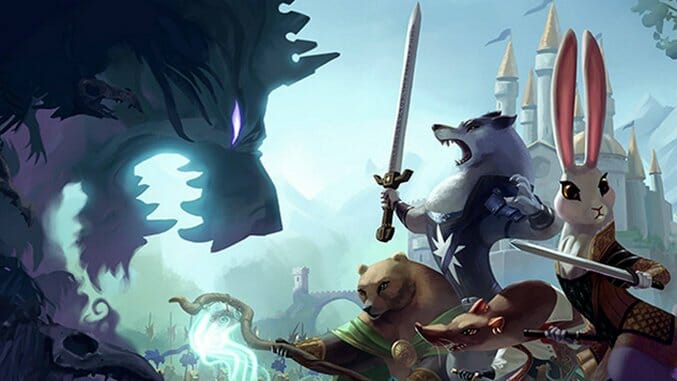
Trent Kusters, the director of game development at League of Geeks, sat across from me on a beautiful Seattle afternoon. We had walked down the block from the bustling hellscape that is the central site of the Penny Arcade Expo, seeking a quiet coffee shop to talk about the past year of Armello updates. Every Australian that I have ever met is precious about their coffee. It takes a true Herculean effort to extract an Australian-approved espresso within the contiguous 48 states, and anyone who has ever had an Australian say “it’s alright” in their coffee-creating establishment should be awarded an internationally-recognized medal accompanied by a monetary prize. So there we were, his coffee steaming next to saran-wrapped cookie he bought, he says, to “keep his energy up”.
“Furries”, he began, “are absolutely amazing.”
Armello is a digital board game by indie game development collective League of Geeks about anthropomorphic animals. Chocolate in your peanut butter; Redwall in your Settlers of Catan; Game of Thrones in your Kung Fu Panda. It’s a beautiful setup that I found lacking back when it was initially released, but the game and its surrounding community has grown quite a bit. “The Usurpers Hero Pack”, the most recent downloadable content pack when I spoke to Kusters, had helped push them into one of their most successful sales days since release.
Kusters credits the active and supportive community for their climbing, measured success. “We had to build a community around a single-player experience,” he explained, and that meant being there for players, communicating with them in the Steam forums and on their own, off-Steam site. They’ve also been generous with free updates, each, like the most recent “Battle Tides,” is the equivalent to a content patch from bigger games like World of Warcraft. League of Geeks uses these updates as an opportunity to tinker with core systems (like reconfiguring the combat system), adding new animations, or changing the way the save system works. Each of them is branded with logos, key art, and all of the other trappings of a game release.
Kusters was clear that this kind of continual support is a two-way street. League does their part with updates, support, and continual communication, but he continually asserted that the strength of the game was in its community. Armello is a complicated game with lots of ins-and-outs, and getting someone into the act of playing is as difficult as it is with any other board game. It takes wikis, advice, and guides to make that work, and Kusters attributed a piece of that welcoming spirit to the furry community as a “bedrock” of the broad fanbase that Armello attracts. Kusters was effusive about how the community had created a “safe space” so that as many people as possible could be introduced to the game at a level they can enjoy.
Continual updates and a strong, responsive community tend to make for successful games, and League of Geeks seem to understand both how good decision making and pure luck have gotten them to this place. Kusters was clear that Armello is a game that is constantly responding to player desires, the vagaries of the designers, and anything that the team thinks might make it better. Many of the features that have gone into the regular free updates have come from an internal wishlist from the developers centered on the question of “what’s the last thing you’d want to see” if the game were never going to be updated again. This gives each update a feeling of moving toward completion or conceptual completeness: these are things the developers and players have always wanted, and now here it is.
League of Geeks has leaned into this iterative approach to fan and developer response by striving to stay experimental with the game both in terms of gameplay and in the broader network of promoting and talking about the game. While Armello has participated in the videogame marketing standard of “site takeovers” and convention booths, they’ve also pushed hard into high-production trailers, developer-focused Twitch streaming, and Facebook advertising in order to cover as much ground as possible for a relatively small indie game. That same spirit extends to the gameplay overhauls of combat, the game’s quest system, and many other tweaks that the devs have pursued over the past year. “If everything is an experiment,” Kusters explained while eating his cookie, “players trust you.”
It’s not all roses, though. Talking about a fumbled downloadable content release, Kusters laughed. “We fucked up so much,” he said, “but I’d rather make these mistakes now instead of on the next thing.” It’s an enviable approach to potential failure, but Kusters seems to be chill enough to roll with it in order to get along to the next piece of releasable content. “I’d rather be talking about new problems, not old fucking problems.”
Every week we hear of new independent developers floundering. We read articles about how broken the economy of games is, how it’s impossible to create games and make money, and how you can do everything right and have everything go wrong. Trent Kusters and the team at League of Geeks have gotten to have it both ways: they can have it go wrong, but they have also figured out how to make it turn out alright in the end with the help of a supportive community and a development team committed to being in dialogue with their players. Kusters seemed infinitely confident about the future of the game and the company at the end of our meeting. He did not, however, comment on the quality of the coffee.